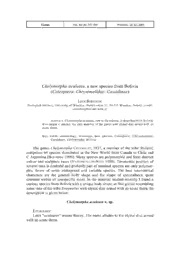
Chelymorpha aculeata, a new species from Bolivia (Coleoptera: Chrysomelidae: Cassidinae) PDF
Preview Chelymorpha aculeata, a new species from Bolivia (Coleoptera: Chrysomelidae: Cassidinae)
Genus Vol. 11 (4): 597-599 Wroc‡aw, 26 XII 2000 Chelymorpha aculeata, a new species from Bolivia (Coleoptera: Chrysomelidae: Cassidinae) LECH BOROWIEC Zoological Institute, University of Wroc‡aw, Sienkiewicza 21, 50-335 Wroc‡aw, Poland, e-mail: [email protected] ABSTRACT. Chelymorpha aculeata, new to the science, is described from Bolivia. It is unique a species, the only member of the genus with elytral disc armed with an acute thorn. Key words: entomology, taxonomy, new species, Coleoptera, Chrysomelidae, Cassidinae, Chelymorpha, Bolivia. The genus Chelymorpha CHEVROLAT, 1837, a member of the tribe Stolaini, comprises 64 species distributed in the New World from Canada to Chile and C Argentina (BOROWIEC 1999). Many species are polymorphic and form distinct colour and sculpture races (VASCONCELLOS-NETO 1988). Taxonomic position of several taxa is doubtful and probably part of nominal species are only polymor- phic forms of some widespread and variable species. The best taxonomical characters are the general body shape and the shape of spermatheca, quite constant within all conspecific races. In the material studied recently I found a curious species from Bolivia with a unique body shape, at first glance resembling some taxa of the tribe Dorynotini with elytral disc armed with an acute thorn. Its description is given below. Chelymorpha aculeata n. sp. ETYMOLOGY Latin (cid:147)aculeatus(cid:148) means thorny. The name alludes to the elytral disc armed with an acute thorn. 598 LECH BOROWIEC DIAGNOSIS It is a unique species, the only within the genus with elytral disc armed with an acute thorn (fig. 2). Some species have extremely gibbous elytra (C. constellata group) but the gibbosity never forms an acute thorn. At first glance, C. constellata (KLUG) is the most similar, especially in body outline, colouration and elytral sculp- ture (figs 4, 6) but differs in gibbous, angulate in profile but not acute elytral disc (fig. 5). DESCRIPTION Male Length: 6.6 mm, width: 5.6 mm, length of pronotum: 2.2 mm, width of pronotum: 4.1 mm, length/width ratio: 1.18, width/length ratio of pronotum: 1.86. Body stout (fig. 1). 1-3. Chelymorpha aculeata; 4-6. Ch. constellata: 1, 4 - male dorsal, 2, 5 - male lateral, 3, 6 - female dorsal CHELYMORPHA ACULEATA, A NEW SPECIES FROM BOLIVIA 599 Pronotum yellowish-brown, along middle with broad yellow band, broad brown to dark brown spots along each side of median yellow band and brown spots on sides of disc. Two median pronotal pits marked with darker brown than the neighbouring area. Elytral disc with groundcolour yellowish brown and punctures with brown areolae; because punctures have a tendency to group in 4- 10, disc appears irregularly maculate, forming a leopard-pattern. Suture between elytral thorn and scutellum dark brown and with yellow, only sparsely maculate, broad band along each side of dark sutural stripe. Explanate margin with irregular radial pattern of brown and yellowish transverse spots in turn. Clypeus and ventrites mostly yellowish, only posterior margin of abdominal sternites brown and lateral gibbosities of metasternum infuscate. Femora and tarsi yellow, tibiae yellow with brown anterior and posterior margins. Antennae gradually infuscate from base to apex, underside of segments 1-4 yellow, upperside slightly infus- cate, segment 5 on underside yellowish-brown on upperside brown, segments 6- 11 brown to black, only underside of apex of last segment with yellow spot. Female Length: 8.4 mm, width: 6.6 mm, length of pronotum: 2.5 mm, width of pronotum: 4.7 mm, length/width ratio: 1.27, width/length ratio of pronotum: 1.68. Body stout, stouter than in related species of C. constellata group but distinctly slimmer than in male (fig. 3). Body colouration like in male but femora in middle with brown spot and anterior and posterior margins of tibiae much broader infuscate. TYPE Holotype male: (cid:147)BOLIVIA: Cochabamba, Cochabamba, 117 km E Yungas (Cochabamba-Villa Tunari Rd.), 1040 m, 17.6.32S 65.41.12W, 10 FEB 1999, R. HANLEY, BOL1H99 064(cid:148) (cid:147)stripe code SMO160247 KUNHM-ENT(cid:148); paratype female: the same data but date (cid:147)1 FEB 1999(cid:148) + (cid:147)BOL1H99 030, ex: miscellane- ous collecting(cid:148) (cid:147)stripe code SMO160332 KUNHM-ENT(cid:148) (preserved at the Snow Entomological Museum, Kansas University, Lawrence, Kansas). REFERENCES BOROWIEC, L., 1999. A world catalogue of the Cassidinae (Coleoptera: Chrysomelidae). Biologica Silesiae, Wroc‡aw, 476 pp. VASCONCELLOS-NETO, J., 1988. Genetics of Chelymorpha cribraria, Cassidinae: colour patterns and their ecological meaning. In: P. JOLIVET, E. PETITPIERRE, T. H. HSIAO, Biology of Chrysomelidae. Kluwer Academic Publishers. Dordrecht/ Boston/ London, 217-232.
